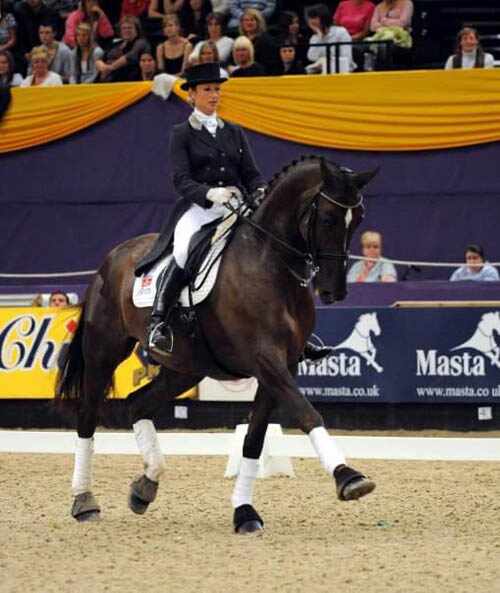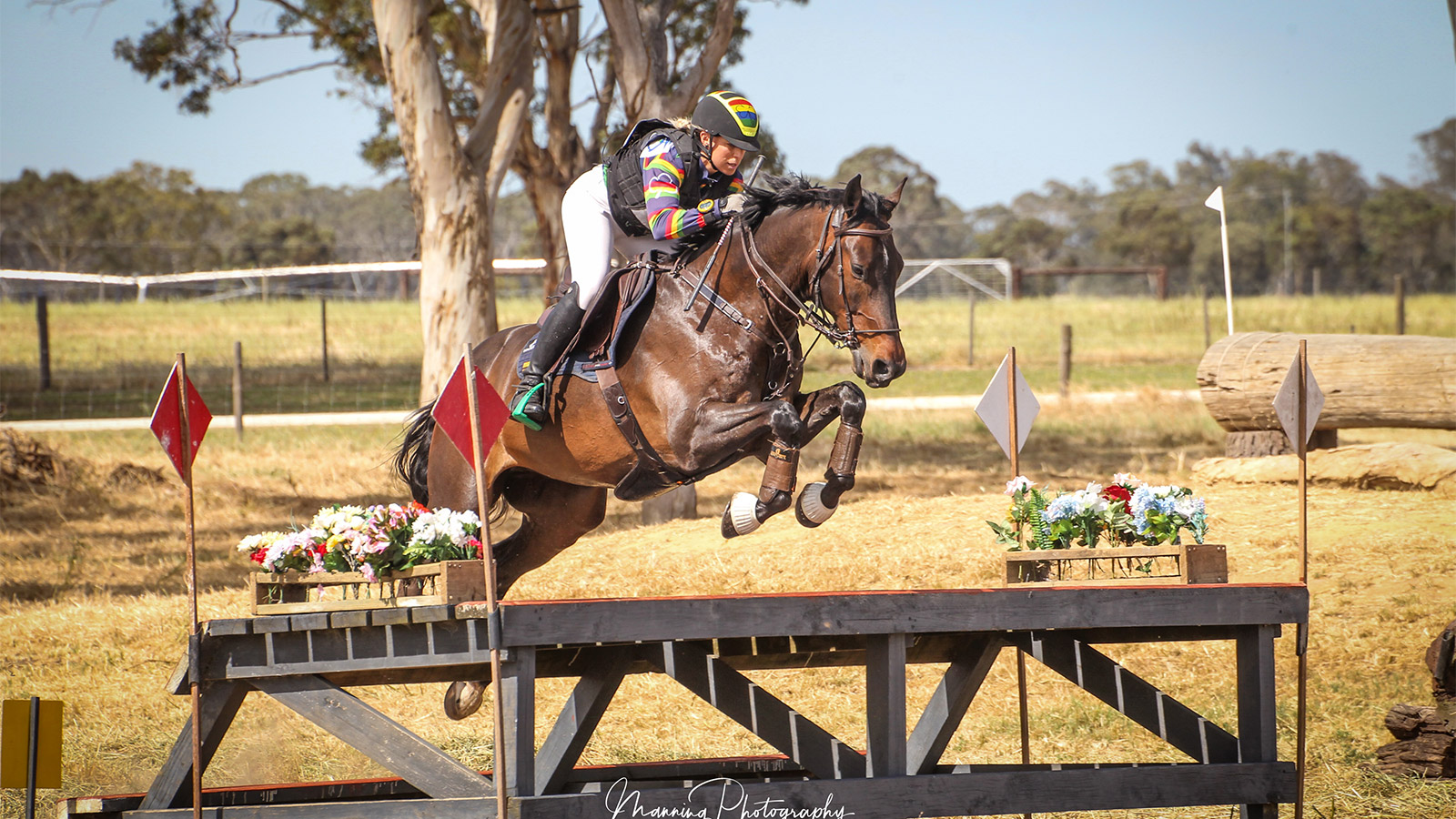It’s a beautiful morning as I drive to meet British dressage rider Amy Stovold at her yard in Horsham, West Sussex. Being a rider myself, I have a basic understanding of the art of dressage and am intrigued to learn more.

Amy with her old Grand Prix horse MacBrian.
“Covid almost forced me
to do this – and I loved it!”
Amy’s yard manager Claire greets me and I am walked through an immaculate yard into Amy’s tack room – the smell of clean leather is the polar opposite of my childhood memories of ill-fitting, unwashed tack and Thelwell ponies and I quickly make a rash assumption that this is a woman born into a world of horses and/or wealth.
The first thing I learn, however, is that Amy’s history contradicts nearly everything that people assume in the world of horses. She wasn’t born with a silver spoon and given her first pony before she could walk – in fact quite the opposite, which makes her story all the more interesting.
Amy’s passion for horses began as a child when she worked at Dorte Semler’s yard as a groom. As time progressed it became the training ground of world-renowned dressage rider Kyra Kyrkland, and between the enthusiasm of Dorte and Kyra they cemented Amy’s firm passion for dressage. It became her life from there on in, but it was her initial experiences with these two incredible mentors that encouraged her determination and set her on a path to a competitive career. She wanted to be the best and to win – all she needed was the right horse.
Amy has competed up to Grand Prix level for Great Britain on a horse called MacBrian. In 2010, they competed at the world-renowned Olympia International Horse Show and finished fifth in a star-studded field. At this point, Amy was selected as part of the World Class Programme – and this was a bit of a turning point, with support ranging from training to sports psychology, nutrition and physiotherapy. From this, Amy was then selected as part of a group who travelled to the Olympics to see the Games as an athlete from backstage. This was a moment that has stayed with Amy, driving her forward and spurring her desire to achieve her goals.
So, the interview begins with me having a core belief in the motives that drive this lady. She is not only ambitious and family orientated, but determined within her sport. A role model for the modern woman, some might say.
You are an athlete and also a mummy. How have you found this transition?
I think if I am honest, I have found it tough – clearly not nearly as bad as some but I am so used to using my body daily for my work and sport that the pregnancy really threw me out of kilter! I am a slightly older mother as well, so the idea of bouncing back and the managing of sleepless nights was a little bit trickier.
I didn’t really take maternity leave as the horses and yard needed me back, but bizarrely enough, I found that Covid almost forced me to do this – and I loved it! I found myself not stressing about all that wasn’t being done, quite simply because I couldn’t do it – and so there I was creating beaches in the garden with Florence and spending hours discussing different butterflies on the downs. I felt I really needed this space and so – whilst money was tough – I am grateful for this time.
My husband is an equine vet so this helps with my horses on a day-to-day basis – it does, however, mean that our conversation round the dinner table can be a little horse heavy!
MacBrian has a special place in Amy’s heart, as he put her on the Grand Prix scene.

Amy on her young horse Kenzo, who she is very excited to see develop his career. © Natalie Harding Photography
Tell us more about Covid – how did it affect your business as a whole?
Ah! Covid! I – like many, I am sure – had high hopes for 2020. At the start of the year, Florence was two and I had various high-profile shows that I was booked into. These types of shows are important because they get you in front of international judges, places such as Addington, Keysoe, Bury Farm and Hickstead – all of which cancelled their schedule within a few weeks.
But this impact wasn’t just on me – I run a yard of liveries that I also teach and manage their horses and, of course, Covid meant liveries weren’t able to come and have lessons and clinics, and most importantly, see their horses. From a teaching perspective I have a lot of clients overseas, especially South Africa, and of course I was unable to travel there either, so everything ground to a halt.

Amy spends a lot of her time giving back to the sport and teaching. © Natalie Harding Photography
“This is the first time in
a long time that I have been
this excited about a horse.”

Amy and family with her up and coming horse, Kenzo. © Natalie Harding Photography
“I’ve been clicker training
for about seven years now.”

What a spunk Bo is! © Natalie Harding Photography
Tell me about your approach to training horses and how it differs from most?
I use a Positive Reinforcement Method with all my horses, especially the young ones. I’ve been clicker training for about seven years now, which includes food. With each click the horse learns the movements from the ground initially – this can be anything from hock flexions to actual dressage moves, but it is easier on the horse without the rider’s load initially and this also builds confidence between horse and rider.
We start using this technique on the ground with clients and it begins with mounting. So, with all our horses – and I encourage all my clients to ensure their horse stands by the mounting block – we get on the horse and wait there until they receive a click and then a treat. Then we get on, click-reward, and they take a treat from our hand. It’s not until we ask them to go that they are allowed to move off. This is a very basic initial example, but quite quickly horses learn and usually clients get on without a contact. This then builds up to more strategic dressage moves in hand.
When I ride, I also use a voice command like the click (a “tsk” sound) and then reward. So, when (for example) I get a clean movement of both hind and front moving at the same time, I reward.
I find this method works from the very basic movements to the very technical, such as piaffe and passage. It definitely reinforces positive behaviours in horses instead of negative and it also gives horses a way to relax. I always say that a happy horse is one that will embrace competition with swagger and confidence.
Amy and her family with Bo. © Natalie Harding Photography
“I find this method works
from the very basic movements
to the very technical.”
Do you then blend your incentive-based training into your teaching?
From the ground to riding, I love to see people training their horses in a compassionate way. People tend to think horses think like humans – that is, “he’s in a bad mood today”– but more often than not this is probably because he’s in pain or some other reason. Riders need help to read the signs and the positive reinforcement groundwork allows us to do this.
From a riding perspective, I concentrate on classical dressage training and encourage people to be body aware whilst riding; you have to be able to use different parts of the body independently.
Many non-riders assume that riding just includes sitting on a horse – it is very, very different! Having said that, I will often go back to the basics with riders and start from the beginning with the main end-goal to allow riders to be more independent.
Much of your socials and website mention Team Stovold. How important are the people and sponsors around you?
They are crucial and this is why our brand is Team Stovold as opposed to just me. For example, my yard manager has been with me for 15 years and knows my horses and I inside out. She is a friend and is the person I want to have by my side in the next chapter and as I rise again in the sport.
Similarly, the equipment I use is massively important – for my saddles I use Bates, which are an Australian-based company that I feel is the most flexible and understanding in their approach. Again, many people assume you just choose a saddle but in actual fact each horse is different, and you need a different saddle for each horse, which has to be fitted. The difference between a badly fitted saddle is night and day; for example, if your saddle isn’t level – making you tip forward or back – you will never be in the centre of the horse, which is crucial.

Kenzo in training with Amy. © Natalie Harding Photography
Finally, tell us about the future!
I hope it is going to be extremely bright post-covid! I have a new horse that I have just bought that I am very excited about – he is young but incredibly powerful and forward thinking. His stable name is Kenzo though you will see him in competitions as Kenjiro Reactive. This is the first time in a long time that I have been this excited about a horse, and I have been looking for over three years – it can be a long game this horse world! People tend to go for breeding but for me it’s the eyes; a kind eye says it all to me. Also, of course, his confirmation, rideability and willingness to work.
As mentioned earlier, I tend to work young horses slowly so I didn’t compete him in 2020, but we have done lots of groundwork and will build up from here and take him to different venues to experience somewhere else. I plan to take him out in (northern) spring and build up – my ultimate goal is Grand Prix but it’s important to take it slow as sometimes you can scare a horse if you apply too much pressure with a high-level test too quickly.
Of course, all of this comes at a cost. Over the years I have been lucky enough to have some amazing owners and investors that have come to support me and watch at every level. Like racing, the owners and investors can enjoy the luxury of attending the shows in the comfort of boxes and seeing their horses perform. I am always open to support from people interested in investing in a horse with me, or even those that would like to see their horse do well. EQ
For more information on supporting Amy in her next steps or simply finding out more about her sport you can follow her socials:










